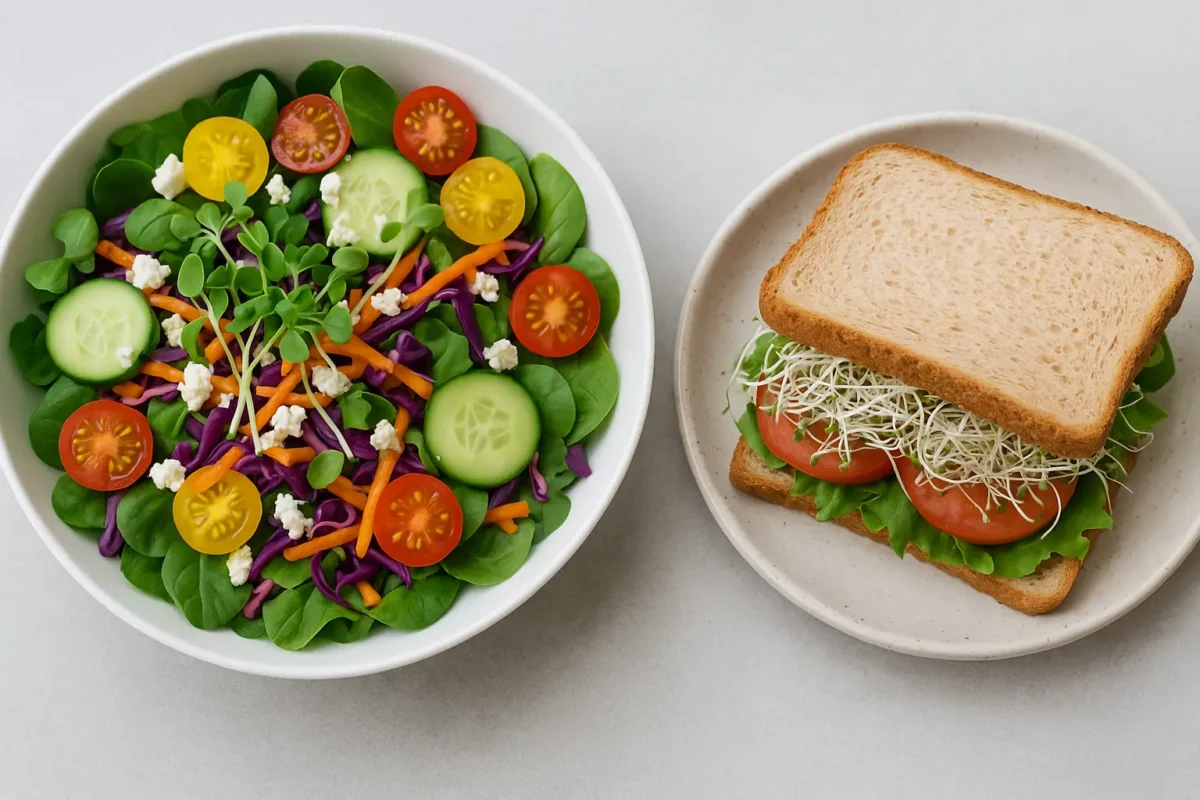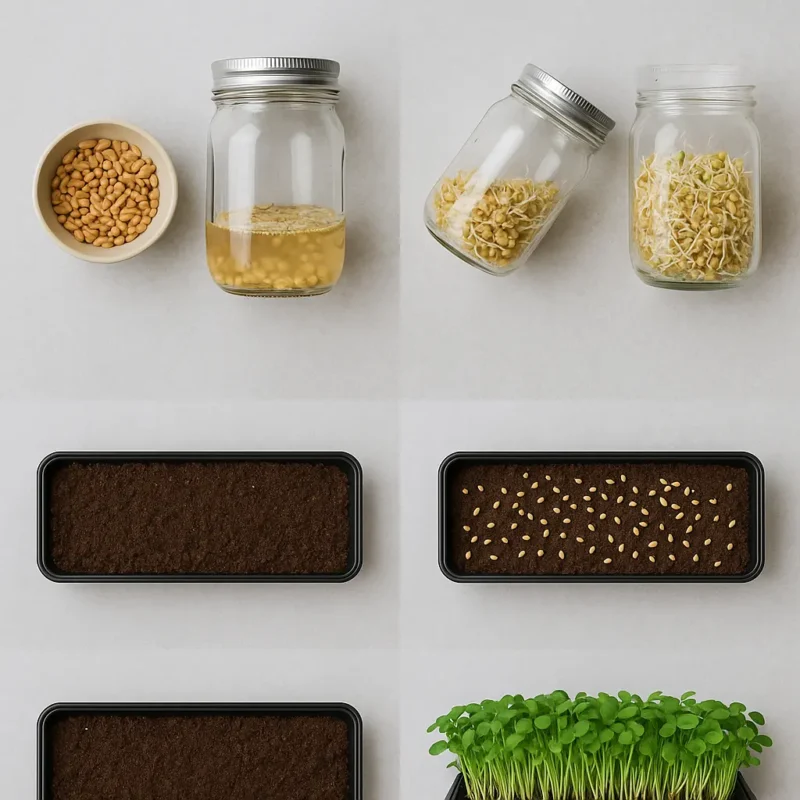
Introduction
Microgreens and sprouts are both trending in health-conscious kitchens, celebrated for their dense nutrition, fast growth, and ability to elevate even the simplest meals. However, despite their similar roles in clean eating and plant-based diets, microgreens vs sprouts is not a matter of preference — they’re fundamentally different in how they’re grown, what they offer nutritionally, and how safe they are to consume raw.
Understanding these differences can help you make smarter choices whether you’re growing at home, shopping for fresh produce, or looking to add more antioxidants and fibre to your plate.
In this article, we explore:
- The difference between microgreens and sprouts
- Their nutritional profiles
- Potential health benefits
- How to grow and store them
- Which one might be better for your needs
Let’s dig in.
What Are Sprouts?
The Basics
In the comparison of microgreens vs sprouts, sprouts are the germinated seeds of plants such as beans, lentils, broccoli, alfalfa, or radish. Grown in water without soil or light, sprouts are typically harvested just a few days after germination, making them quick and easy to produce at home.
Growing Conditions
- Grown in water (hydroponic)
- Ready to eat in 2–4 days
- Entire seed, root, and shoot are consumed
- Grown in warm, humid environments
Common Types of Sprouts
- Alfalfa
- Mung bean
- Lentil
- Broccoli
- Clover

Food Safety Note
Due to the humid growing conditions, sprouts are more prone to bacterial contamination like E. coli or salmonella. The NHS and Food Standards Agency recommend caution, especially for pregnant women, the elderly, and those with compromised immunity (FSA guidance).
What Are Microgreens?
The Basics
In the discussion of microgreens vs sprouts, it’s important to understand what microgreens actually are. Microgreens are young seedlings of edible vegetables and herbs, grown in soil or alternative growing mediums like coco coir. They’re harvested just after the first true leaves emerge — typically between 7 and 21 days after germination — making them nutrient-dense and full of flavour.
Growing Conditions
- Grown in soil or growing mats
- Require light and air circulation
- Only the stem and leaves are eaten (not the root)
- Harvested with scissors just above soil level
Popular Microgreens
- Broccoli
- Radish
- Pea shoots
- Red cabbage
- Mustard

Nutritional Comparison
Which Is More Nutritious?
When comparing microgreens vs sprouts, both are rich in nutrients, but microgreens typically contain higher concentrations of vitamins, minerals, and antioxidants. Their more developed leaves allow them to absorb more light and nutrients, giving them a nutritional edge over sprouts.
According to a 2012 study by the USDA and University of Maryland, microgreens can contain up to 40 times more nutrients than their mature plant counterparts (Xiao et al., 2012).
| Nutrient | Sprouts | Microgreens |
| Vitamin C | Moderate | High |
| Vitamin K | Low to moderate | High |
| Beta-Carotene | Low | High |
| Polyphenols | Low | High |

Flavour and Culinary Uses
Flavour Profiles
- Sprouts: Mild, slightly earthy, watery texture
- Microgreens: More intense flavour – peppery (radish), nutty (sunflower), sweet (pea)
How Microgreens vs Sprouts Are Used in Everyday Meals
- Sprouts: Sandwiches, salads, smoothies
- Microgreens: Gourmet garnishes, salads, soups, wraps
Microgreens are widely used by chefs for their flavour punch and visual appeal.

Safety and Shelf Life
Shelf Life
- Sprouts: 2–5 days in the fridge
- Microgreens: 7–10+ days (if stored correctly)
Safety Concerns
When it comes to food safety in the microgreens vs sprouts debate, sprouts are more prone to bacterial contamination because they’re grown in warm, moist environments without sunlight. In contrast, microgreens are typically cultivated in clean soil or growing mediums with proper airflow and light, making them generally safer to eat raw.

Growing at Home
Equipment Needed
| Item | Sprouts | Microgreens |
| Growing medium | Water (jar/tray) | Soil or grow mat |
| Light | Not required | Needed (sunlight/LED) |
| Harvest time | 2–4 days | 7–21 days |
| Space needed | Very small | Small tray or windowsill |
Ease of Growing
- Sprouts are quick and beginner-friendly
- Microgreens require slightly more setup but offer greater versatility and nutritional payoff

Which Should You Choose?
Choose Sprouts If…
- You want something quick and easy to grow
- You plan to cook or blend them (e.g. in soups or smoothies)
- You can monitor cleanliness closely
Choose Microgreens If…
- You value higher nutrition and stronger flavours
- You want something beautiful for plating and presentation
- You are concerned about food safety when eating raw
Final Thoughts
In the microgreens vs sprouts comparison, both have their strengths. Sprouts are an easy entry point for beginners looking to grow fresh greens at home. However, when it comes to superior nutrition, flavour, and culinary versatility, microgreens clearly come out on top.
With a bit of preparation and the right storage methods, microgreens can become a powerful addition to your healthy lifestyle — whether in salads, sandwiches, or smoothies.
Sources:
Food Standards Agency UK – Sprouts Safety
University of Maryland Extension
The Antioxidant Power of Microgreens: 5 Outstanding Health Benefits You Need to Know

